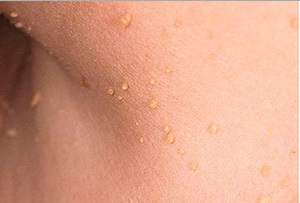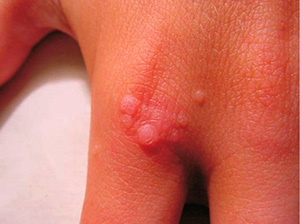
Papillomas or warts are the most common disease. The presence of growths on the skin is noted in 80% of the population. This defect is caused by the human papillomavirus (HPV). Neoplasms can occur on any part of the body: on the neck, arms, face, external genitals, as well as in the internal visceral organs. However, at first glance, these not dangerous neoplasms can degenerate into malignant formations and cause melanoma - skin cancer.
Papillomas are formed from the superficial skin epithelium (warts) and the mucous membrane of internal organs (condylomas). They can be of various shapes, for example, round or clavate, mainly towering above the skin and have a typical color. Each wart has the same type of structure: a base formed from connective tissue (collagen and elastin, in the composition of loose fibrous tissue, give elasticity to the stroma skeleton), and blood capillaries located in the center of the wart.
Why do small papillomas appear on the body
The only reason for any growths on the body is HPV damage, due to a weakened immune system. There are about 120 known types of virus. Infection most often occurs after an inflammatory process. The viral activity of HPV depends on the immune status and the individual response of the human body.
Minor damage to skin areas, various microtrauma, violation of the epidermal barrier allow the virus to penetrate into the upper layers of the skin. This virus does not circulate with the bloodstream, but is located directly in the dermis. Therefore, the incubation period is not less than 3 and not more than 5 months. It proceeds with latent symptoms. Only after 5 months there will be noticeable clinical changes. The double DNA helix, which is part of it, ensures relapses of the disease, even after an immune response or clinical cure, since a single DNA is retained in the cells of the epidermis.
There are four main causes of virus infection:
- Contact and household reason - physical contact (handshake) with the carrier of this virus, as well as the use of personal hygiene items of the patient.
- Suppressed action of the general and local immune system, due to the existing inflammatory process or constant stress.
- From mother to child (anogenital warts). Transmitted at birth and has a high risk of progression and a large area of distribution.
- Sexual contact with a patient with HPV in 50% of cases.

Infection by contact-household route ranks first in terms of the number of cases. The hands are the most exposed and unprotected part of the body. Therefore, small papillomas often appear on the hands.
Papillomas are subdivided into several morphological classifications.
By size, there are: small and large papillomas.
Warts are shaped like:
- Ordinary- localized on the free belt of the upper extremities: palmar surface of the hand, phalanges of the fingers, elbow, dorsum of the hand. They are spherical.
- Simple- found all over the body, more often located on the neck and arms. They have the appearance of a gray bubble that rises above the skin.
- Pointed- look like a cockscomb. They are small and white in appearance, club-shaped.
- Seborrheic keratosesare age-related warts. Keratinous, not carrying a pathogenic character due to a different origin.
- Spinesare the roughest and toughest. Often large and high above the skin.
By location: plantar (hands and feet), flat (papillomas on the body), ordinary (hands), butcher's warts (on the plantar surface of the foot).
Etiology of warts: congenital and acquired.
Most often, small papillomas may appear among patients. And it is this type that is capable of forming groups.
What is the danger of small papillomas
The danger of small papillomas is that they are hardly visible on the body and may appear unexpectedly. This increases the risk of contracting HPV.

If after skin contact you have small warts, be sure to visit a dermatologist. A highly specialized doctor will be able to differentiate the type of papilloma and the period of its existence, which will serve as the basis for prescribing treatment.
Do not rip off, do not try to get rid of small papillomas on your own, and even more so with the help of folk methods. You can do yourself a disservice! Since benign neoplasms have a risk of degeneration into oncology, the resulting growths must be removed in the clinic.
Some types of human papillomavirus are highly oncogenic. And they can provoke not only skin cancer (melanoma), but also cancer of the cervix (in women) and the anal ring (in men), the formation of polyps of internal organs.
Papillomas on the body, located in places where friction is increased or their damage must be urgently removed! To avoid pathologies.
How to remove small papillomas using different methods
Since this defect occurs more often in women than in men, the removal of warts is mostly initiated by patients. Even for no apparent reason. How to remove papillomas on the body?
Medication type of treatment:
- The use of drugs that affect the immune system. Immunomodulators and immunocorrectors, immunostimulants and other drugs that are immunotropic, enhance the immune response and normalize a specific impaired link of the immune system.
- Use of intramuscular injections and rectal suppositories with antiviral effect in combination with vitamins.
- Medications are prescribed to enhance the immune response, which stimulate the production of their own interferons.
- The use of herbal medicine for general strengthening of the body.
Surgical type of treatment:
- Surgical excisionis the very first method of removing papillomas. It is common among other types. Excision of the wart is carried out with all underlying tissues. The effectiveness of this method is 65%, and the entire relapse is about 30%. A side effect of surgical excision is scarring. This technique is used to remove papillomas localized on the lower extremities.
- Chemical coagulation- burning warts with chemicals. Used 95% silver nitrate, 17% salicylic acid and cantharidin. The most potent is cantharidin. By penetrating into the lower layers of the skin and destroying the wart. A long and expensive method. The efficiency of this technique is about 80%.
Methods for removing very small papillomas
How to remove a "very small" papilloma? In modern clinics, there are a huge number of techniques for removing small warts without cosmetic defects.
If you intend to quickly and effectively get rid of annoying growths all over your body, here are some of the best techniques for removing very small growths:
- Cryotherapy.Freezing with liquid nitrogen. The fastest and most affordable technique will take no more than 15 minutes. Recommended for removing papillomas located on the face and neck.
- Laser destruction method.There are several types of laser. The most popular is the carbon dioxide laser. Final healing comes 7 days after surgery. Recommended for hard-to-reach warts.
- Photodynamic therapy for warts.Conducted using a long wavelength of light. The most effective method (95%), the build-ups will be easily removed and no scars remain.
Prevention of small growths
Preventing disease is always easier than curing! Let this slogan become your credit for life. In the prevention of the appearance of papillomas, it is important to lead a healthy lifestyle. Give up bad habits (smoking) for your health! Strengthen the immune system and start treatment on time, if required. Relieve stress and get more rest. Try to eat right, get enough sleep, and spend time outdoors. Monitor your health, visit the clinic every year and routine check-ups. If you suspect HPV or papilloma, contact your doctor immediately. Follow the rules of prevention and you will not care about any disease.













































































